Profit Is Best Described As
Profit Maximization Definition
Profit maximization can be divers equally a process in the long run or
short run to identify the well-nigh efficient manner to increase profits.
It is mainly concerned with the determination of price and output
level that returns the maximum turn a profit. Information technology is an important assumption
that helped economists in the formulation of various economic theories,
such as price and production theories.
Table of Contents
- 1 Turn a profit Maximization Definition
- ii Profit Maximisation Formula
- 2.1 Outset Order Condition
- 2.ii Second Gild Status
- three Profit Maximisation in Short Run
- iii.one Nether Perfect Contest
- 3.2 Under Imperfect Competition
- iv Profit Maximisation in Long Run
- 4.1 Under Perfect Competition
- four.ii Under Imperfect Competition
- 5 Business concern Economics Tutorial
Turn a profit Maximisation Formula
According to conventional economists, profit maximization is the simply objective of organisations, making it every bit the base of conventional theories. It is as well regarded as the nigh reasonable and productive business organization objective of an organisation.
In addition, profit maximization helps in determining the behaviour of business organisations and issue of various economic factors, such as price and output, in dissimilar market place conditions.
The total profit (Π) of a business organisation is calculated by taking the divergence between Total Acquirement (TR) and Full Cost (TC). Thus,
Π =TR- TC
Turn a profit is maximum when the difference between the total revenue and total cost is maximum.
For profit maximization, two conditions must exist fulfilled, namely, the
- First lodge condition
- Second order status
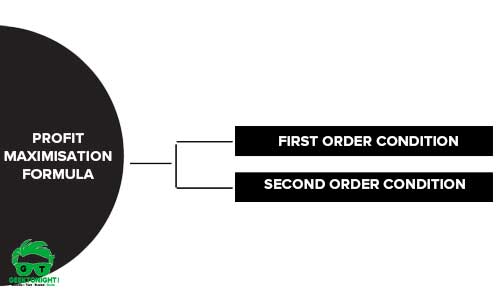
First Guild Condition
Under first lodge condition, Marginal Revenue (MR) should exist equal to Marginal Cost (MC).
Marginal revenue can exist defined equally the acquirement generated from auction of the last unit of output, on the other hand, marginal cost can be described as the price incurred in the production of one additional unit of output. Both TR and TC functions involve a common variable, which is output level (Q).
The showtime order status states that the offset derivative of turn a profit must be equal to nothing.
Nosotros know Π =TR- TC
Taking its derivative with respect to Q,
∂Π / ∂Q = ∂TR/ ∂Q -∂TC/ ∂Q= 0
This condition holds but when ∂TR/ ∂Q = ∂TC/ ∂Q
∂TR/ ∂Q provides the slope of the TR curve, which, in turn, gives MR.
On the other paw, ∂TC/ ∂Q gives the slope of the TC bend, which is
the aforementioned as MC. Thus, the first-lodge condition for profit maximisation
is MR=MC.
Second Guild Condition
Second order condition requires that the first social club status must
be satisfied in case of decreasing MR and ascent MC. This condition is
shown in Figure i:
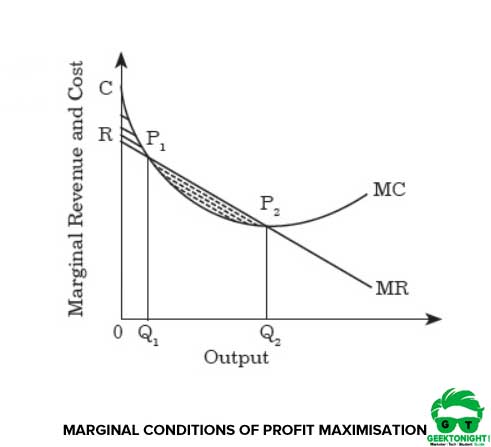
As shown in Figure 1, MR and MC curves are derived from TR and TC functions. Information technology tin also be observed from Effigy 1 that MR and MC curves intersect at points P1 and P2. At point P2, MR is less than MC, thus, the second order condition is satisfied at indicate P2. Numerically, the 2nd order status is given as:
∂2Π / ∂Q2 = ∂2TR/ ∂Q2 — ∂2TC/ ∂Q2
∂2TR/ ∂Q2 — ∂2TC/ ∂Q2 < 0
∂2TR/ ∂Q2 < ∂2TC/ ∂Q2
Slope of MR < Gradient of MC
From the aforementioned equation, it can be concluded that MC must have a steeper slope than MR or MC must intersect from below. Thus, turn a profit is maximised when both the showtime and 2nd order weather condition are satisfied.
As mentioned, profit maximisation happens both in the short run as well every bit long run. Let united states study about both the cases in the subsequent sections.
Profit Maximisation in Curt Run
Brusk run tin be defined as a time menses in which at least one input is fixed. However, the flow of time that can be considered as the curt run is completely dependent on the manufacture's characteristics.
For instance, service industries can reach profit in 2 weeks afterward operations. In this case, two weeks tin be considered as short run. In the short run, profit maximisation occurs in different types of market structures ( perfect competition and imperfect competition ).
Let us study well-nigh the profit maximisation in these 2 market structures:
- Nether Perfect Competition
- Under Imperfect Competition
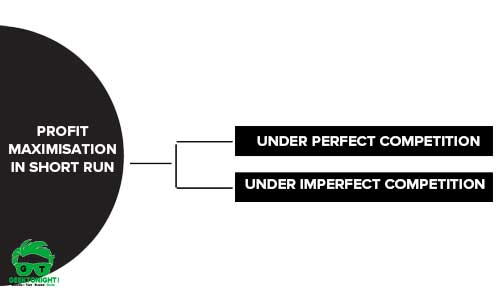
Under Perfect Competition
Equally discussed earlier, under perfect competition, a big number of buyers exist producing the aforementioned products.
Thus, the turn a profit-maximising output is determined at the point where extra revenue obtained by selling the last unit of measurement becomes equal to the marginal cost incurred in the production of that unit. Figure 2 shows the profit maximisation nether perfect competition:
In Figure 2, D is the demand bend and the condition of profit maximisation is satisfied at the bespeak Qc, where toll equals marginal price. If the quantity to exist produced is increased by the organisation, the marginal revenue Pe becomes less than the marginal costs, as shown past the bend MC. This in turn decreases the profits.
Thus, Qc is the short run equilibrium point, where MR = MC. Therefore, the organisation needs to produce an output level of Qc in society to maximise its profit nether perfect competition.
Under Imperfect Contest
Nether imperfect competition, organisations are responsible for determining the profit maximising charge per unit of output levels and price. The demand, marginal revenue and toll curves for a profit maximising organisation under imperfect competition is shown in Effigy 3:
In Figure 3, it tin can be seen that at point Qc, the turn a profit of the system is maximised. At Qc, the corresponding cost is Pc equally shown by the need curve D.
Thus, at the quantity produced Qc, marginal revenue becomes equal to marginal cost, i.e., MR = MC. The profit earned by the organisation is depicted by the shaded expanse.
Profit Maximisation in Long Run
Long run can be described as the time period in which all the inputs are variable. Like to profit maximisation in the short run, organisations maximise profits under perfect competition and imperfect competition. Let us study about the profit maximisation in these ii market structures:
- Under Perfect Competition
- Under Imperfect Competition
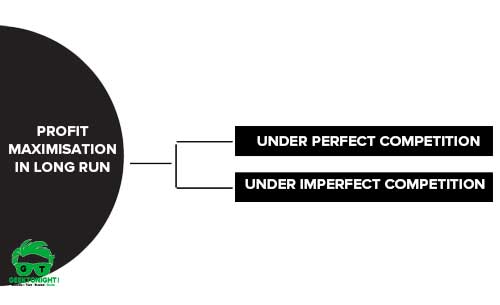
Nether Perfect Competition
As mentioned, in the long run, all inputs are variable. Similar to short run, in the long run, an arrangement must satisfy the condition of MR = MC to maximise its profit. Figure iv shows the profit maximisation of an organisation under perfect competition:
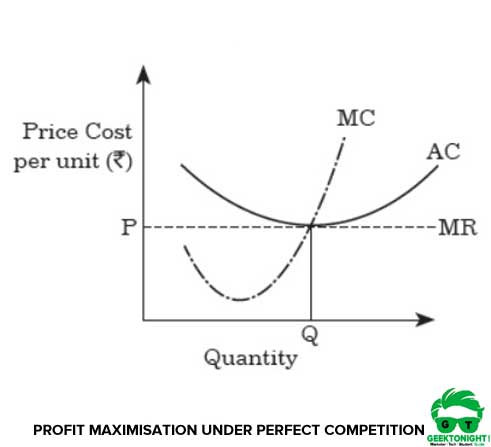
In Effigy 4, the profit maximising level of output, where marginal cost equals marginal revenue, results in an equilibrium quantity of Q units of output. Thus, the equilibrium point at which the system maximises its profit in perfect contest is at the output rate Q.
Under Imperfect Competition
In the long run, the profits are similar to the manner generated in perfect contest. Therefore, an organisation maximises its profit by equalising its marginal revenue and marginal costs. Effigy 5 shows the profit maximisation of an system under imperfect contest:
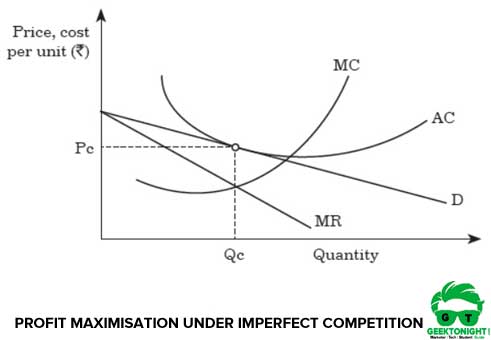
From Figure 5, information technology tin be concluded that to maximise its profit the arrangement must produce the quantity Qc units at the cost Pc. Also, in Figure v, demand curve is tangent to average cost equalising cost and average toll at Pc and Qc.
Thus, there is no telescopic of economic profits for other firms, restricting their entries in the markets. Therefore, Pc and Qc are the equilibrium points for the organisations for a long period of time in imperfect competition.
Besides Read: What is Demand Forecasting ?
Business organization Economic science Tutorial
( Click on Topic to Read )
Keep, Share commodity with Friends
Did nosotros miss something in Business Economics Tutorial? Come on! Tell u.s.a. what yous think about our article on Profit Maximisation | Business Economic science in the comments section.

Profit Is Best Described As,
Source: https://www.geektonight.com/profit-maximization/
Posted by: valdezwhemere.blogspot.com


0 Response to "Profit Is Best Described As"
Post a Comment